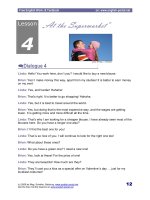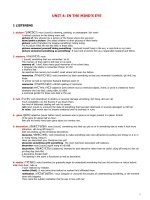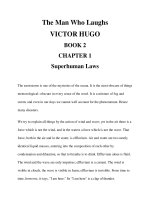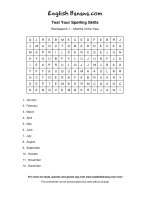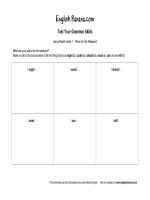4 1 4 painting the southwest (realistic fiction)
Bạn đang xem bản rút gọn của tài liệu. Xem và tải ngay bản đầy đủ của tài liệu tại đây (2.69 MB, 8 trang )
Reader
Painting the
Southwest
by Ladislao Gutierrez
Genre
Realistic
Fiction
Build Background
Access Content
Extend Language
• The American
Southwest
• Land and
People
• Art
•
•
•
•
• SpanishEnglish
Cognates
• Desert Words
Fine Art
Labels
Map
Definitions
Scott Foresman Reading Street 4.1.4
ì<(sk$m)=bebjag< +^-Ä-U-Ä-U
ISBN 0-328-14190-9
Talk About It
1. Choose a painting in this book. Talk about the
details in the painting. What does the painting
show about life in the Southwest?
2. How is Grandpa’s style of painting different from
the style of Mr. Williams?
Painting the
Southwest
Write About It
3. What did you learn about the Southwest? Make a
chart on a separate paper.
by Ladislao Gutierrez
The Land
The Animals
The plains
had grass.
Cattle ate
grass.
The People
Extend Language
Use this book and other sources to find more
words that describe the desert. Make a web of
words about deserts.
Photographs
Every effort has been made to secure permission and provide appropriate credit for photographic material. The
publisher deeply regrets any omission and pledges to correct errors called to its attention in subsequent editions.
Unless otherwise acknowledged, all photographs are the property of Scott Foresman, a division of Pearson
Education.
Cover Ann Alexander/©Artistic Images Prescott; 1 Ann Alexander/©Artistic Images
Prescott; 2 Ann Alexander/©Artistic Images Prescott; 3 ©Digital Wisdom, Inc.; 4 Ann
Alexander/©Artistic Images Prescott; 5 Ann Alexander/©Artistic Images Prescott; 6 Ann
Alexander/©Artistic Images Prescott; 8 Ann Alexander/©Artistic Images Prescott; 9 Ann
Alexander/©Artistic Images Prescott; 11 ©Getty Images; 12 ©David Muench/Corbis.
ISBN: 0-328-14190-9
Copyright © Pearson Education, Inc.
All Rights Reserved. Printed in the United States of America.
This publication is protected by Copyright, and permission should be obtained from
the publisher prior to any prohibited reproduction, storage in a retrieval system,
or transmission in any form by any means, electronic, mechanical, photocopying,
recording, or likewise. For information regarding permission(s), write to: Permissions
Editorial Offices:
Glenview, 1900
Illinois
• Parsippany,
New
Jersey • New
York,
New York
Department,
Scott Foresman,
East
Lake Avenue,
Glenview,
Illinois
60025.
Sales Offices: Needham, Massachusetts • Duluth, Georgia • Glenview, Illinois
• Sacramento,
California
1 2 3 4 5 6 7 8 9Coppell,
10 V0G1Texas
14 13
12 11 10 09 08
07 06 05• Mesa, Arizona
Wyoming
Nebraska
art gallery
Nevada
Utah
Colorado
Kansas
California
Arizona
Oklahoma
New Mexico
Texas
painting
Stop, Thief!
My grandfather is an artist. He lives in Skull
Valley, Arizona. I visit him from New Jersey every
summer. Grandpa takes me to art galleries. An
art gallery is a building or a room used to show
art, such as paintings and sculptures, which are
statues and other carved art. We talk about the
paintings. Grandpa tells me about the artists and
the materials they use—things like oil paints,
pens, pencils, watercolors, and pastels.
Grandpa tells me, “Every artist has something
to say. An artist talks to us through paintings and
sculptures. Artists share their ideas and feelings
in their art.”
2
MEXICO
-
%
8
)
#
/
I want to be an artist when I grow up.
Today, we are looking at watercolors by
Norton Williams. Mr. Williams lived in California
and the Southwest in the 1900s. For many years,
he was a painter for the United States Navy.
When Mr. Williams grew older, he moved to
Arizona. He saw cowboys and Native Americans.
He saw small pueblos and ranches. He spent time
in the desert. He used watercolors and pastels
to paint the people and places of the American
Southwest.
pueblos: Native American villages of the Southwest
3
The next painting also confuses me. I ask
Grandpa, “What’s that behind the woman? It
looks like a city.”
“Some native people lived in cities. Some
didn’t.” says Grandpa. “There were cities all over
the Southwest. Some of the old cities were big.
Most of them were small pueblos. Some were
built on the tops of cliffs, or into mountainsides.”
Winter Wood, a painting by Norton Williams of Navaho
people and their hogan (house), dog, and burro
“Mr. Williams tells stories in his art,” I say.
“Yes,” says Grandpa. “He uses watercolors
to tell us about life in the Southwest long ago.
He tells stories about Native Americans and
cowboys, hogans and pueblos, about burros and
horses, about pioneers and ranchers.”
I look closely at a painting, and I feel
confused. “That looks like snow on the ground. I
thought the Southwest was all desert.”
Grandpa laughs. “It can snow in the desert. A
desert is just a place with very little rain. It isn’t
all sand and cactus. Up in the mountains, there
is high desert. You can have tall pine trees in the
high desert. You can even have snow up there.
There must be trees nearby. These people are
gathering wood for fires.”
A Stroll with the Twins
4
5
Next, we look at a watercolor of an old town.
The people in it look Hispanic, like people in my
family.
“The next folks to come to the Southwest
were Hispanic,” says Grandpa. “The Southwest
used to be part of Mexico. Now California,
Arizona, New Mexico, Texas, and other states are
part of the United States. We Mexican Americans
still live here.”
Grandpa and I like this painting a lot.
Hispanic: from Spain or Latin America
Grandpa explains, “The Mexican people built
villages or towns too. Some people lived in town.
Others rode in to the towns on horses or in
wagons. They didn’t go to town very often.
“In those days, people made almost
everything they needed at home. They went to
town to buy things
they couldn’t make,
such as tools and
saddles for their
horses. Some people
went to church and to
the bank in town too.”
I look closely at the
painting. “The woman
probably bought her
bucket in town,” I
tell Grandpa. “I bet
the girl bought her
umbrella there too.”
Extend Language
Cognates
Sometimes a word in one language sounds or looks
like a word in another language. If these words have
similiar meanings, they are called cognates. Cognates
can help you learn a new language. Here are some
English-Spanish cognates. Can you name others?
South of the Border
6
English
bank
desert
mountain
Spanish
banco
desierto
montaña
7
A painting of cowboys is next. I know all
about cowboys. Many came to the Southwest to
drive cattle to market. They kept the cattle in big
groups or in long lines to go across the land. That
was called a “cattle drive.”
Cowboys called the land where the cattle
grazed, or ate grass, “the range.” Sometimes the
land was a prairie or plains where grasses grew.
Sometimes the land was a desert of sand and
cacti and not much grass.
Grandpa points to the chuckwagon in the
painting. A cook kept his pots and pans and all
his cooking tools in the chuckwagon. When the
cowboys stopped for the night, he could cook
them a meal. He could cook anywhere.
Heading in
market: a place to buy and sell things
Cowboys were out on the range a lot. They
didn’t see many people until they got their cattle
to market. I look at another painting. “Those
cowboys are in the middle of nowhere!” I say
to Grandpa.
“Yes,” says Grandpa. “I think cowboys liked to
have a lot of land around them. Even now, parts
of the Southwest don’t have very many people—
compared to the Northeast.”
Grandpa lives far from other people too. I
think many of the people of the Southwest still
like having lots of land around them.
Beans and Coffee
8
9
I think about the watercolors as we drive
home. The truck shakes as we drive across a dry
riverbed. I say, “Things were softer long ago.
Weren’t they, Grandpa?” Grandpa looks at me
with interest. He wants to know what I mean. I
explain, “Mr. Williams used soft colors in all his
paintings. I think he wanted us to know that
times were soft too. They were gentle.”
Grandpa smiles. “The people worked hard in
those days, just as we do today. Life was hard
back then. But I know what you mean. Life was
full of chores, but life was not fast. People spent
more time at home and in nature.”
“That’s why Mr. Williams didn’t use many bright
or very dark colors,” I decide. “He showed us a
quiet time.”
chores: tasks, jobs
10
in nature: outdoors
11
Talk About It
1. Choose a painting in this book. Talk about the
details in the painting. What does the painting
show about life in the Southwest?
2. How is Grandpa’s style of painting different from
the style of Mr. Williams?
Write About It
3. What did you learn about the Southwest? Make a
chart on a separate paper.
The Land
The Animals
The plains
had grass.
Cattle ate
grass.
The People
Extend Language
Use this book and other sources to find more
words that describe the desert. Make a web of
words about deserts.
Photographs
Every effort has been made to secure permission and provide appropriate credit for photographic material. The
publisher deeply regrets any omission and pledges to correct errors called to its attention in subsequent editions.
Back at Grandpa’s house, I watch him paint.
Grandpa is painting a picture of his own house.
He uses oil paints. Oil paints are thick. Grandpa
paints with bright colors. Grandpa paints a
colorful sunset. His colors seem loud and lively
to me!
“I liked Mr. Williams’s paintings,” I say. “But I
like the way you paint too!”
“Every artist has a special style,” Grandpa says.
“I wonder how you will paint one day.”
“I do, too,” I reply. “I do, too!”
12
Unless otherwise acknowledged, all photographs are the property of Scott Foresman, a division of Pearson
Education.
Cover Ann Alexander/©Artistic Images Prescott; 1 Ann Alexander/©Artistic Images
Prescott; 2 Ann Alexander/©Artistic Images Prescott; 3 ©Digital Wisdom, Inc.; 4 Ann
Alexander/©Artistic Images Prescott; 5 Ann Alexander/©Artistic Images Prescott; 6 Ann
Alexander/©Artistic Images Prescott; 8 Ann Alexander/©Artistic Images Prescott; 9 Ann
Alexander/©Artistic Images Prescott; 11 ©Getty Images; 12 ©David Muench/Corbis.
ISBN: 0-328-14190-9
Copyright © Pearson Education, Inc.
All Rights Reserved. Printed in the United States of America.
This publication is protected by Copyright, and permission should be obtained from
the publisher prior to any prohibited reproduction, storage in a retrieval system,
or transmission in any form by any means, electronic, mechanical, photocopying,
recording, or likewise. For information regarding permission(s), write to: Permissions
Department, Scott Foresman, 1900 East Lake Avenue, Glenview, Illinois 60025.
1 2 3 4 5 6 7 8 9 10 V0G1 14 13 12 11 10 09 08 07 06 05
